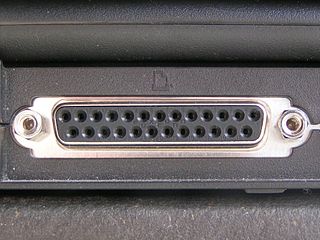
In computing, a printer is a peripheral machine which makes a persistent representation of graphics or text, usually on paper. While most output is human-readable, bar code printers are an example of an expanded use for printers. The different types of printers include 3D printer, inkjet printer, laser printer, thermal printer, etc.
In computing, a device driver is a computer program that operates or controls a particular type of device that is attached to a computer or automaton. A driver provides a software interface to hardware devices, enabling operating systems and other computer programs to access hardware functions without needing to know precise details about the hardware being used.
PostScript (PS) is a page description language in the electronic publishing and desktop publishing business. It is a dynamically typed, concatenative programming language. It was created at Adobe Systems by John Warnock, Charles Geschke, Doug Brotz, Ed Taft and Bill Paxton from 1982 to 1984.
In digital printing, a page description language (PDL) is a computer language that describes the appearance of a printed page in a higher level than an actual output bitmap. An overlapping term is printer control language, which includes Hewlett-Packard's Printer Command Language (PCL). PostScript is one of the most noted page description languages. The markup language adaptation of the PDL is the page description markup language.
A page printer is a computer printer which processes and prints a, whole page at a time, as opposed to printers which print one line or character at a time such as line printers and dot-matrix printers. Page printers are often all incorrectly termed “laser printers”—although virtually all laser printers are page printers, other page printing technologies also exist

The LaserWriter is a laser printer with built-in PostScript interpreter sold by Apple Computer, Inc. from 1985 to 1988. It was one of the first laser printers available to the mass market. In combination with WYSIWYG publishing software like PageMaker, that operated on top of the graphical user interface of Macintosh computers, the LaserWriter was a key component at the beginning of the desktop publishing revolution.

In computing, a parallel port was a type of interface found on computers for connecting peripherals. The name refers to the way the data is sent; parallel ports send multiple bits of data at once, as opposed to serial communication, in which bits are sent one at a time. To do this, parallel ports require multiple data lines in their cables and port connectors and tend to be larger than contemporary serial ports, which only require one data line.
The Graphics Device Interface (GDI) is a Microsoft Windows application programming interface and core operating system component responsible for representing graphical objects and transmitting them to output devices such as monitors and printers.
An interface description language or interface definition language (IDL), is a generic term for a language that lets a program or object written in one language communicate with another program written in an unknown language. IDLs describe an interface in a language-independent way, enabling communication between software components that do not share one language, for example, between those written in C++ and those written in Java.

An MFP, multi-functional, all-in-one (AIO), or multi-function device (MFD), is an office machine which incorporates the functionality of multiple devices in one, so as to have a smaller footprint in a home or small business setting, or to provide centralized document management/distribution/production in a large-office setting. A typical MFP may act as a combination of some or all of the following devices: email, fax, photocopier, printer, scanner.

A computer terminal is an electronic or electromechanical hardware device that can be used for entering data into, and transcribing data from, a computer or a computing system. The teletype was an example of an early day hardcopy terminal, and predated the use of a computer screen by decades.

CUPS is a modular printing system for Unix-like computer operating systems which allows a computer to act as a print server. A computer running CUPS is a host that can accept print jobs from client computers, process them, and send them to the appropriate printer.
In computers, a printer driver or a print processor is a piece of software on a computer that converts the data to be printed to a format that a printer can understand. The purpose of printer drivers is to allow applications to do printing without being aware of the technical details of each printer model.

IEEE 1284 is a standard that defines bi-directional parallel communications between computers and other devices. It was originally developed in the 1970s by Centronics, and was widely known as the Centronics port, both before and after its IEEE standardization.
In telecommunications networks, a node is either a redistribution point or a communication endpoint. The definition of a node depends on the network and protocol layer referred to. A physical network node is an electronic device that is attached to a network, and is capable of creating, receiving, or transmitting information over a communication channel. A passive distribution point such as a distribution frame or patch panel is consequently not a node.
HP Jetdirect is the name of a technology sold by Hewlett-Packard that allows computer printers to be directly attached to a Local Area Network. The "Jetdirect" designation covers a range of models from the external 1 and 3 port parallel print servers known as the 300x and 500x, to the internal EIO print servers for use with HP printers. The Jetdirect series also includes wireless print server models, as well as gigabit Ethernet and IPv6-compliant internal cards.

USB On-The-Go is a specification first used in late 2001 that allows USB devices, such as tablets or smartphones, to act as a host, allowing other USB devices, such as USB flash drives, digital cameras, mouse or keyboards, to be attached to them. Use of USB OTG allows those devices to switch back and forth between the roles of Host and Device. A mobile phone may read from removable media as the Host, but present itself as a Device when connected to a Host computer.
UniDrv is a GDI-based Microsoft Windows universal printer driver and architecture for non-PostScript printers. It is used to simplify driver development of non-PostScript printers for printer manufacturers. Unidrv allows the creation of a printer-specific minidriver in the form of a GPD file, similar to a PPD file, which is much simpler than kernel mode driver development. Unidrv was introduced in Windows 2000 and replaced the Raster Device Driver (RASDD) interface used in Windows NT 4.0 and earlier versions.
Windows Vista has many significant new features compared with previous Microsoft Windows versions, covering most aspects of the operating system.
HP Universal Print Driver (UPD) is an intelligent print driver that supports a broad range of HP LaserJet printers and MFPs. Developed by Hewlett-Packard, it combines a general purpose driver and HP proprietary extensions. HP UPD simplifies driver deployment and management. This advanced print driver has the ability to discover HP printing devices and automatically configure itself to the device capabilities.







